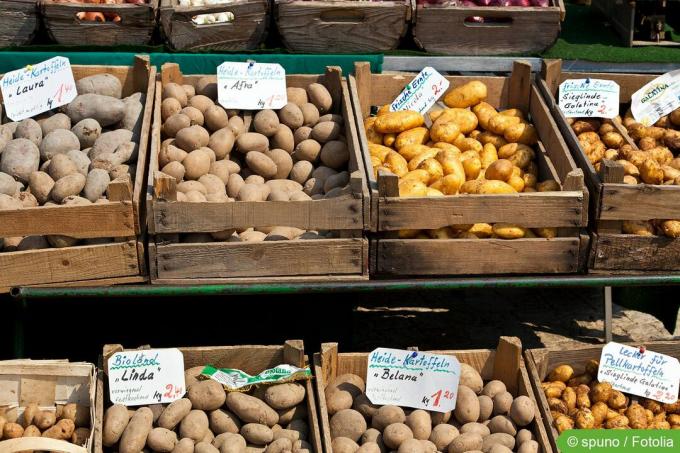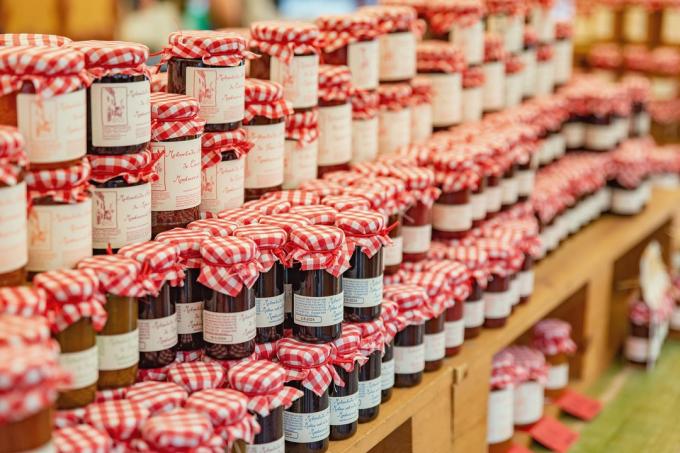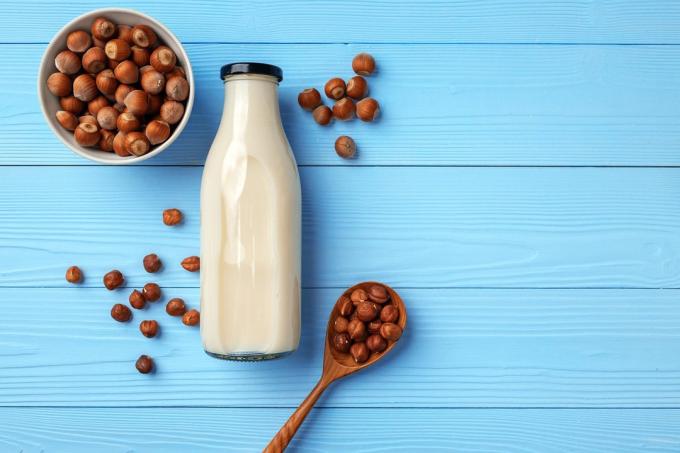

Table of contents
- Private sale without business registration
- Sale with business registration
- hygiene regulations
- food labeling
- protection of minors
- frequently asked Questions
Selling homemade groceries is an interesting way for many people to earn some extra money on the side or to start their own business. Before implementation, it is important to know which requirements and laws must be observed in order to avoid problems afterwards.
Private sale without business registration
Essential when selling homemade food is how you present it and what kind of product it is. For the majority, you need either a permit from your municipality or a business registration. If it is instead unaltered food that you have grown yourself, you usually do not have to observe any regulations. This is a direct sale that is primarily suitable for the following locations (original production):
- field or field
- own property

If you want to offer your products unchanged at the weekly or Christmas market instead, you must inform your municipality. Each municipality makes different demands on the producer or charges a fee. Once you have received your approval, you can start selling. The situation is somewhat different with products that “predominantly come from our own cultivation”. This refers to products whose ingredients are largely self-produced and prepared with other ingredients. These include jams and juices in particular. You can also offer these without a business registration, as long as the third-party shares, such as sugar, do not exceed 50 percent. You can find out the exact values from the responsible health authority in your federal state. Before you can offer products from "mainly home-grown" for sale, you still have to consider the following points:
- Carry out food labelling
- Instruction according to § 43 para. 1 of the Infection Protection Act (IfSG)
- Training according to Regulation (EC) No. 852/2004 on food hygiene
A notice:
Depending on the commune or municipality, it may be the case that a business registration is required even for products that are “predominantly home-grown”. Before making the offer, be sure to find out whether this is the case where you live.
Sale with business registration
A business registration is required for the sale of homemade food if this exceeds 50 percent Contain third-party shares, are easily perishable or have a sales area that is not on private property Tobe offered. These include, for example, the following:
- farm shops
- supermarkets
- own company
- online stores

Furthermore, it should be noted that for food of animal origin not only a business registration is required, but also an EU approval for food companies. Without this you are not allowed to sell the products. Eggs are an exception. If you have fewer than 350 chickens, you may sell eggs privately as described above under the Poultry Hygiene Regulations 2007. There are no other regulations to be observed. Otherwise you need a trade license, although a small trade license is sufficient for many products. In addition to the IfSG instruction, food labeling and food hygiene training, you must also observe other requirements for your business:
- Documentation of all work steps and origin of the ingredients according to the EU basic regulation (No. 178/2002)
- Requirements for the cold chain
- Requirements of veterinary medicine for the company
- Food safety according to the Food and Feed Code (LFGB)
- Protection against deception by the Food and Feed Code (LFGB)
hygiene regulations
If you want to sell homemade food that is not a primary product, you must observe strict hygiene regulations. They protect consumers from illnesses that can result from improper food handling or poor hygiene. In this case, it is not enough that the ingredients are clean. The instruction and training mentioned above informs you and all those involved, such as possible employees about the following topics, so that the products and their handling are harmless to health are:
- possible pathogens in food
- disease prevention
- Obligation to report contamination
- proper cleaning and disinfection of the premises
- Process of food hygiene documentation
- Use of the black and white principle
food labeling
A frequently overlooked point in the self-selling of groceries is the labeling of the products. As a manufacturer, you must provide a large amount of information in accordance with the Food Information Regulation (Regulation (EU) No. 1169/2011). These are important for the consumer so that they are sufficiently informed about your products. That means you have to take care of a label and also present the essential information online if you offer your products packaged or via an online shop.
The essential information is:
- Designation or “brand name” of the food
- Ingredients including labeling of allergens
- net weight
- drained weight
- capacity
- Net filling quantity
- Best before date (optional: recommended use by date)
- nutritional labeling
- address of the manufacturer
- country of origin
- Quality class (strongly product-dependent)
It is also important to state possible hazardous substances such as colors or preservatives that you have added to the product. The ingredients are divided into a list of the ingredients and their amount in percent. With a jam, for example, you often have to state how much sugar was used. Furthermore, it should be noted that each federal state can make further requirements for the labeling, since the LMIV primarily applies to all EU countries. For this reason, it is essential that you contact the responsible nutrition office to find out what information is still required. Furthermore, the names of the foods must not be misleading, which can often be the case with vegetarian or vegan food. Here, for example, the following terms are available as alternatives:
- Milk: hazelnut drink
- Cream cheese: oat spread
- Sausage: Meat substitute made from pea protein

A notice:
The food information regulation is only necessary for products that are made from several ingredients or are offered in packaged form. For example, if you sell fresh vegetables directly from a stand, labeling is unnecessary.
protection of minors
Depending on the food on offer, the necessary youth protection regulations must be observed. It is primarily about the sale of alcoholic beverages such as home-brewed beer or fruit liqueurs. The most important information can be found in JuSchG § 9 (alcoholic beverages). In order to sell alcohol, you not only need a business, you also have to make sure that your buyers have reached a certain age. This depends on the alcohol offered:
- 16 years and older: fermented alcohols such as beer, wine, sparkling wine or cider
- 18 years and older: spirits such as brandy, tequila or vodka

Most brandies have an alcohol content of at least 15 percent. In order to be allowed to sell the alcohol, you must also ensure that all products are labeled as soon as they exceed a volume of 1.2 percent. It is also important to ensure that an age check is carried out when the product is sold and that you, as the seller, do not sell the products to buyers who are too young. This can be done, for example, using the following methods:
- ID card or passport check
- Proof of age via online banking (ID Pass)
- video review
- POSTIDENT
A notice:
Also pay attention to the protection of minors if you offer foodstuffs filled with alcohol, such as chocolates. Due to their filling, they are also among the products that may not be sold to consumers under the age of 18.
frequently asked Questions
The PAngV states that you offer your products for the final price. This already includes the sales or value added tax and possible additional costs that are part of the price for you as the manufacturer. The PAngV protects consumers from possible price increases after purchase.
That depends on the landlord. It is advisable to ask the landlord before registering the business whether the premises may be used for this purpose. If not, you will have to find additional premises suitable for commercial activities.
If you are employed full-time, in most cases you will need a permit from your employer to be able to carry out part-time work. Selling groceries counts as a secondary activity. However, for many employers, selling groceries is not a problem as long as it is not a competitor.
A business is not enough for that. You also need a liquor license (concession) according to Section 3 of the Pub Act (GastG). You can obtain this from the responsible public order office in your municipality. Without the liquor license, alcohol may not be directly sold and enjoyed.
 Maike
Maike
Learn more about legal

Does the stairwell count towards the living space?
Of course, real estate agents, house sellers or landlords want to state the living space of an apartment or house as high as possible, as this drives up the price. But is it even permissible to include stairs in the calculation? Read here whether the stairwell is part of the living space.

Costs of a preliminary building inquiry using the example of an EFH
A preliminary building inquiry provides more planning security when building a house, can save money and effort and is therefore often useful. When making the request, builders should pay attention to a few points in order to avoid delays and problems. We provide information about the costs of a preliminary building application using the example of a single-family house (EFH).

Calculate base area number (GRZ) correctly
If you want to build on a property in this country, you will inevitably encounter the area number (GRZ). This is a value for determining the permissible development area of the property. We will explain how to correctly calculate the number of base areas.

Noise protocol: sample and PDF template for printing
Noise means stress for many people and can make you ill in the long run. Persistent noise does not have to be simply accepted. In order to prove a disturbance of the peace, it makes sense to keep a noise log. Here you will find a pattern as a PDF template for printing.

Calculate floor area ratio (GFZ) correctly
BMZ, GRZ, GFZ: If you want to build, you will come across a large number of terms and key figures that you should definitely know. In this article, we will tell you what the floor area ratio is all about and how to calculate it correctly.

Shell land: what is that? | definition
If you want to fulfill your dream of owning your own home, you will stumble across confusing terms when looking for a suitable plot of land. Read here what raw building land is all about and why you can save money when purchasing it.
